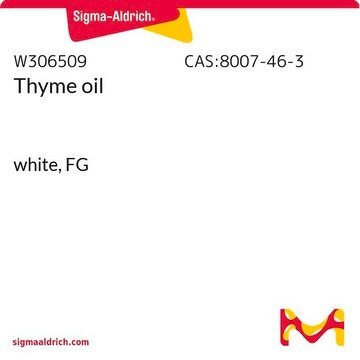W224511
Carvacrol
natural, 99%, FG
Synonyme(s) :
5-Isopropyl-2-methylphenol
About This Item
Produits recommandés
Qualité
FG
Fragrance grade
Halal
Kosher
natural
Agence
follows IFRA guidelines
meets purity specifications of JECFA
Conformité réglementaire
EU Regulation 1223/2009
EU Regulation 1334/2008 & 178/2002
FDA 21 CFR 117
Pureté
99%
Indice de réfraction
n20/D 1.522 (lit.)
Point d'ébullition
236-237 °C (lit.)
Pf
3-4 °C (lit.)
Densité
0.976 g/mL at 20 °C (lit.)
Application(s)
flavors and fragrances
Documentation
see Safety & Documentation for available documents
Allergène alimentaire
no known allergens
Allergène de parfum
carvacrol
Propriétés organoleptiques
camphoraceous; woody; spicy
Chaîne SMILES
CC(C)c1ccc(C)c(O)c1
InChI
1S/C10H14O/c1-7(2)9-5-4-8(3)10(11)6-9/h4-7,11H,1-3H3
Clé InChI
RECUKUPTGUEGMW-UHFFFAOYSA-N
Vous recherchez des produits similaires ? Visite Guide de comparaison des produits
Description générale
Application
- Prophylactic efficacy of baicalin and carvacrol against Salmonella Typhimurium biofilm on food and food contact surfaces.: The study explores the effectiveness of carvacrol in preventing biofilm formation by Salmonella Typhimurium, with implications for food safety (Ashrafudoulla et al., 2024).
Mention d'avertissement
Danger
Mentions de danger
Classification des risques
Acute Tox. 4 Oral - Aquatic Chronic 2 - Eye Dam. 1 - Skin Corr. 1B
Code de la classe de stockage
8A - Combustible corrosive hazardous materials
Classe de danger pour l'eau (WGK)
WGK 3
Point d'éclair (°F)
>212.0 °F
Point d'éclair (°C)
> 100 °C
Certificats d'analyse (COA)
Recherchez un Certificats d'analyse (COA) en saisissant le numéro de lot du produit. Les numéros de lot figurent sur l'étiquette du produit après les mots "Lot" ou "Batch".
Déjà en possession de ce produit ?
Retrouvez la documentation relative aux produits que vous avez récemment achetés dans la Bibliothèque de documents.
Les clients ont également consulté
Notre équipe de scientifiques dispose d'une expérience dans tous les secteurs de la recherche, notamment en sciences de la vie, science des matériaux, synthèse chimique, chromatographie, analyse et dans de nombreux autres domaines..
Contacter notre Service technique








